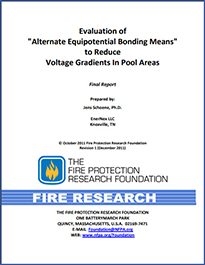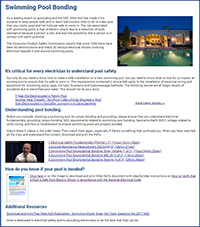
May is electrical Safety Month. We'd like to bring your attention to a Fire Protection Research Foundation report on the NFPA website, called Evaluation of Alternate Equipotential Bonding Means to Reduce Voltage Gradients in Pool Areas, authored by Jens Schoene, Ph.D., EnerNex LLC, Knoxville, TN.
The Foreword:
 A common approach to reduce the voltage gradients in a pool area is by using a single buried #8 AWG copper conductor following the perimeter surface around the pool. This is identified as an alternate means of perimeter equipotential bonding for permanently installed swimming pools and spas according to 680.26(B)(2)(b) of the 2011 edition of NFPA 70®, National Electrical Code® (NEC®). A common approach to reduce the voltage gradients in a pool area is by using a single buried #8 AWG copper conductor following the perimeter surface around the pool. This is identified as an alternate means of perimeter equipotential bonding for permanently installed swimming pools and spas according to 680.26(B)(2)(b) of the 2011 edition of NFPA 70®, National Electrical Code® (NEC®).
This arrangement is intended to provide a 60 Hz ac voltage gradient protection to prevent injury or death, but questions exist on its effectiveness. This includes defining nominal "safe" levels based on differentiating between conditions that are tolerable (i.e., benign or an irritant) versus dangerous, and evaluating nominal performance of the conductor with respect to these levels.
This project provides information that clarifies the effectiveness of "alternate equipotential bonding means" for swimming pools and similar installations. A specific focus is provided on the impact on voltage gradients from the use of a single #8 AWG copper ring installed according to the requirements of 680.26(B)(2)(b) of the NEC.
The Research Foundation expresses gratitude to the report author Jens Schoene, Ph.D., along with Vadim Zheglov, Sharanya Jaganathan, and other members of his research team, all of whom are with EnerNex LLC located in Knoxville, Tennessee. During this research effort, significant input and guidance was provided by the Electric Power Research Institute through Douglas Dorr and others. In addition, the Research Foundation appreciates the guidance provided by the Project Technical Panelists, and all others that contributed to this research effort. Special thanks are expressed to the National Fire Protection Association (NFPA) for providing the project funding through the NFPA Annual Code Fund.
The content, opinions and conclusions contained in this report are solely those of the author.
Visit the NFPA website here, or click on the image, to read the report.
 For additional information on Swimming Pool Bonding,visit Mike Holt's web page which has important Swimming Pool Bonding videos and a link to Mike's document with step-by-step instructions on How to Verify That a Pool is Safe from Electric Shock, in accordance with the National Electrical Code. For additional information on Swimming Pool Bonding,visit Mike Holt's web page which has important Swimming Pool Bonding videos and a link to Mike's document with step-by-step instructions on How to Verify That a Pool is Safe from Electric Shock, in accordance with the National Electrical Code.
|
|

